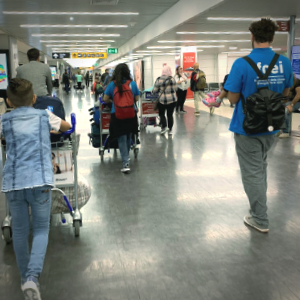Humanitarian corridors project helps people displaced from Syria, Yemen, and Iraq residing in Lebanon secure visas to fly to Italy, France and, to a lesser extent, Germany, Switzerland, Andorra, and San Marino.
These ‘aerial bridges’ allow beneficiaries to claim asylum upon arrival. It is run and funded by civil society groups and faith-based organisations, with government authorisation. It provides one of the few options for asylum-seekers to fly in the hopes of receiving asylum in Europe.
The rationale behind these ‘corridors’ is simple: there are people in need in Lebanon, and there are communities willing to host and support in countries in Europe.
Staff often describe the project as a “relief valve” from the pressures of living in Lebanon.
Lebanon in 2020
For many, this year is becoming synonymous with the devastating effects of the pandemic, but for Lebanon, it is just another hurdle.
Protests that started last year demanding economic and social reforms are still ongoing, led to the resignation and then reinstatement of Prime Minister Hariri and a new cabinet. However, the government—a fragile coalition shared between 18 of the country’s recognised sects—has yet to address protesters’ demands and faces a huge debt, rampant corruption, and a currency in rapid decline.
The explosion of 2,750 tons of unsafely stored ammonium nitrate for years on the 4th of August left a wake of destruction across Beirut. Experts classified it as one of the biggest non-nuclear explosions of all time. Neighbourhoods are on the mend, but—with a pandemic and an economic crisis in the mix—recovery will take years.
“The blast exacerbated pre-existing conditions of vulnerability”, said a former project field coordinator.
Adapting to COVID
The humanitarian corridors project staff are no strangers to adaptation. The project is a constant negotiation between the Lebanese and European host governments. Administration in Rome recalled all staff back to Italy in March, when the country closed its borders, but staff returned in late July after the airport in Beirut was reopened.
In the meantime, staff continued conducting virtual interviews with potential beneficiaries. A staff member said a huge part of the job was “reassuring without giving false hope”. They observed that everyone’s situation had worsened as daily work ceased to be an option for many Syrians.
Back in Beirut, the return to normalcy was slowed by restrictions, lockdown, the effects of the blast and staff contracting COVID.
Since March, the project has been immobility. With cases increasing in Europe, the relocation of people was stalled, creating a backlog of people trapped in uncertainty. The corridor resumed in October, with 50 people leaving for Italy and 30 for France. However, this process involves more forms, two PCR exams, medical clearance from both governments, and quarantine upon arrival on top of the usual security checks.
Photo credit: © Halima Tanjaoui
About the author: Hannah Markay is an editor at Routed Migration and Immobility Magazine and a part-time LLM student in Public International Law at the University of Oslo. After graduating from the MSc in Refugee and Forced Migration Studies at the University of Oxford, she spent some time working for the Humanitarian Corridors Project in Lebanon. Twitter: @hcmarkay
